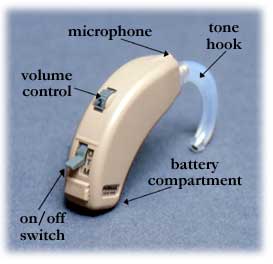 A hearing aid is a device used to help hard-of-hearing people hear sounds better. In the past, a funnel-like amplification cone, called an “ear trumpet” or “ear horn” was used. Also sometimes used was a desk with a built-in amplifier into which a microphone and earphones could be plugged; these worked better than passive ear trumpets but were not portable.
A hearing aid is a device used to help hard-of-hearing people hear sounds better. In the past, a funnel-like amplification cone, called an “ear trumpet” or “ear horn” was used. Also sometimes used was a desk with a built-in amplifier into which a microphone and earphones could be plugged; these worked better than passive ear trumpets but were not portable.

Now, however, the most common style is a small electronic device that fits into the wearer’s ear. The first variety of this device had a rectangular battery pack connected by a thin wire, intended to be held in a pocket. Such “body aids,” though much more portable than the desk type, still suffered significant disadvantages due to sub-optimal microphone placement. Since the microphone was not near the user’s head, it was susceptible to interfering sounds such as clothing-noise. Sound input was also distorted if the microphone was located below the mouth of a person with whom the user was conversing.

During the mid- to late 20th century, hearing aids that were carried in pockets were replaced by a more inconspicuous sort of model in which small zinc-air batteries were placed in the inserted unit itself. Cutting-edge technology allows for hearing aids so small and stylish they can be mistaken for wireless headsets.

(a) Over-the-ear aid with case open to show internal components. (b) In-the-ear aid. (c) In-the-canal aid. (Belltone Electronics Corp.)
Pictures of hearing aids


Types of hearing aids
Body worn aids
This was the first type of hearing aid, and thanks to developments in technology they are now rarely used. These aids consist of a case containing the components of amplification and an ear mold connected to the case by a cord. The case is about the size of a pack of playing cards and is worn in the pocket or on a belt. Because of their large size, body worn aids are capable of large amounts of amplification and were once used for profound hearing losses. Today, body aids have largely been replaced by Behind-The-Ear (BTEs) instruments.

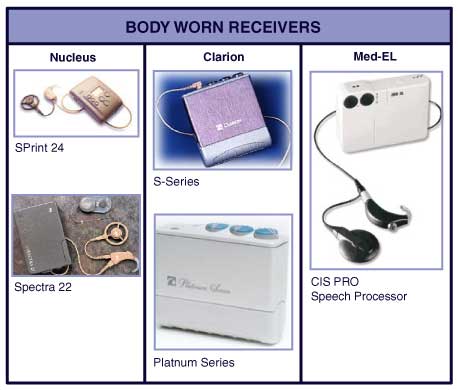
Behind the ear aids (BTE)

BTE aids have a small plastic case that fits behind the ear and conducts sound to the ear canal, usually through an earmold that is custom made. BTEs can be used for mild to profound hearing losses and are especially useful for children because of their durability and ability to connect to assistive listening devices such as classroom FM systems. Their colors range from very inconspicuous skin tones for adults to bright colors and optional decorations for children.


Recent innovations in BTEs include miniature “invisible” BTEs with thin hair-like sound tubes (see open-fit devices below). These are often less visible than In-The-Ear (ITEs) and some keep the ear canal more open so listeners may still utilise their residual natural hearing (most helpful for those with normal hearing in the lower frequencies). Ideal for high frequency losses, these miniature versions are generally used for mild to moderate hearing loss.

In the ear aids (ITE)

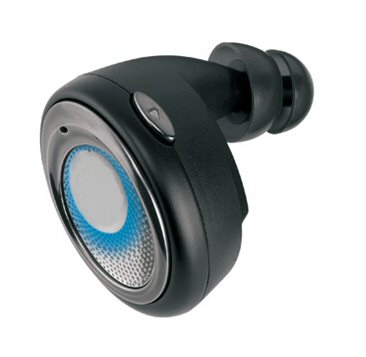
These devices fit in the outer ear bowl (called the concha);they are sometimes visible when standing face to face with someone.

(EAR ANATOMY)
ITE hearing aids are custom made to fit each individual’s ear. They can be used in mild to some severe hearing losses. Feedback, a squealing/whistling caused by sound leaking out of the aid and being amplified again, may be a problem for severe hearing losses. Some modern circuits are able to provide feedback regulation or cancellation to assist with this.

Traditionally, ITEs have not been recommended for young children because their fit could not be as easily modified as the earmold for a BTE, and thus the aid had to be replaced frequently as the child grew. However, there are new ITEs made from a silicone type material that mitigates the need for costly replacements.
Receiver in the ear aids (RITE)
At a first glance, these devices are similar to the BTE aid. There is however one crucial difference: The receiver of the hearing aid is placed inside the ear canal of the user and thin electrical wires replaces the acoustic tube of the BTE aid. There are some advantages with this approach: First, the hearing aid receiver is placed further from the hearing aid microphone. This reduces the risk of acoustic feedback (commonly denoted “howl”.) Second, the tube connecting the hearing aid and the ear-plug (also commonly referred to as “dome” or ear-mould) can be made extremely thin. This makes it possible to design an even smaller hearing aid that is even more inconspicuous.
In the canal (ITC), mini canal (MIC) and completely in the canal aids (CIC)


ITC aids are smaller, filling only the bottom half of the external ear. You usually cannot see very much of this hearing aid when you are face to face with someone.
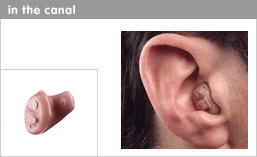
MIC and CIC aids are even smaller and often not visible unless you look directly into the wearer’s ear. These aids can be used for mild to moderately-severe losses.
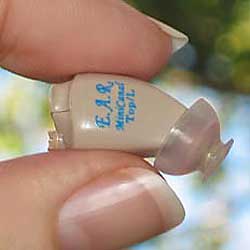
(MINI CANAL HEARING AID)
CICs are usually not recommended if you have good low frequency hearing as the “plugged up effect” may make your voice resonate (the “occlusion effect”).
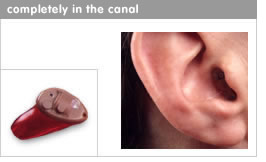
Open-fit devices

Recently a new device has come on the market, the “Open-fit” or “Over-the-Ear” OTE Hearing Aid. Usually quite discrete, these are small Behind-the-ear type devices, with a much finer clear tube that runs down into the ear canal. Inside the ear canal, there is a small soft silicone dome or a molded, highly vented acrylic tip that holds the tube in place.
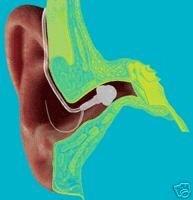
These devices are designed to reduce the “occlusion effect”, which is the amplification of your own voice when your ears are plugged up (try sticking your fingers in your ears and talking).
Conversely they increase the possibility of feedback, and as such are limited to moderate high frequency losses. Open-fit devices are very beneficial for High-Frequency hearing losses, and have been introduced by all major hearing aid companies.
Bone Anchored Hearing Aids (BAHA)
The BAHA is a auditory prosthetic which can be surgically implanted. The BAHA uses the skull as a pathway for sound to travel to the inner ear.


For people with conductive losses, the BAHA, bypasses the external auditory canal and middle ear, stimulating the functioning cochlea. For people with unilateral hearing loss, the BAHA uses the skull to conduct the sound from the deaf side to the side with the functioning cochlea.
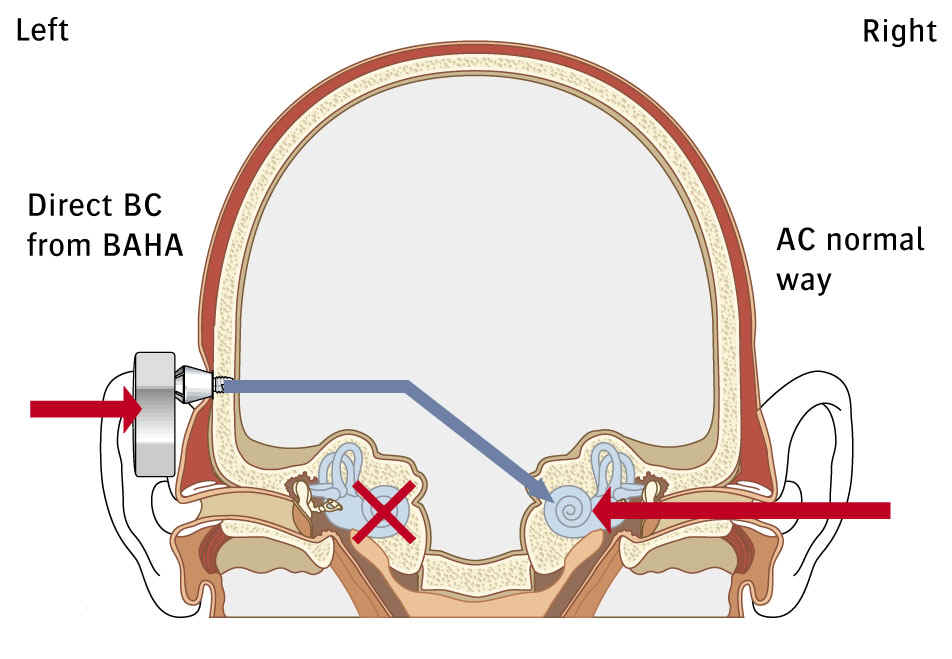
Individuals under the age of 5 typically wear the BAHA device on a headband. Over age 5, a titanium “post” can be surgically embedded into the skull with a small abutment exposed outside the skin. The BAHA sound processor sits on this abutment and transmits sound vibrations to the external abutment of the titanium implant. The implant vibrates the skull and inner ear, which stimulate the nerve fibers of the inner ear, allowing hearing.

(BAHA HEARING AID)
Eyeglass aids
During the late 1950s through 1970s, before in-the-ear aids became common (and in an era when thick-rimmed eyeglasses were popular), people who wore both spectacles and hearing aids frequently chose a type of hearing aid that was built into the temple pieces of the spectacles. However, the combination of glasses and hearing aids was inflexible: the range of frame styles was limited, and the user had to wear both hearing aids and glasses at once or wear neither. Today, most people who use both glasses and hearing aids simply use in-the-ear types. There still are some specialized situations where hearing aids built into the frame of eyeglasses can be useful, such as when a person has hearing loss mainly in one ear: sound from a microphone on the “bad” side can be sent through the frame to the side with better hearing.
This can also be achieved by using CROS or bi-CROS style hearing aids, which are now wireless in sending sound from the “bad” or “worse” side to the better side. These types of hearing aids are much more frequently used than any eyeglass style.

Recently, a new type of eyeglass aid has been introduced by the Dutch company Varibel. These ‘hearing glasses’ feature directional sensitivity: four microphones on each side of the frame effectively work as two directional microphones, which are able to discern between sound coming from the front and sound coming from the sides or back of the user. This allows for amplification of the sound coming from the front, the direction in which the user is looking, and suppression of sound coming from the sides or back. Only very recently has the technology required become small enough, in size, to be put in the frame of the glasses. As a recent addition to the market, the geographical market for this particular hearing aid is currently limited to a few European countries.
Hearing aid technology
Wireless
Recent hearing aids include wireless hearing aids. One hearing aid can transmit to the other side so that pressing one aid’s program button simultaneously changes the other aid and both aids change background settings simultaneously. FM listening systems are now emerging with wireless receivers integrated with the use of hearing aids. A separate wireless microphone can be given to a partner to wear in a restaurant, in the car or in another room. The voice is transmitted wirelessly to the hearing aids reducing the effects of distance and background noise.
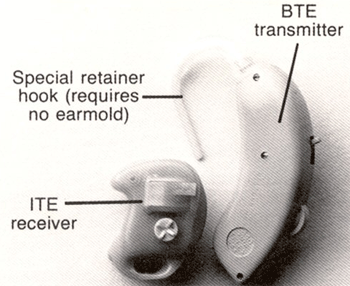
Many theatres and lecture halls are now equipped with assistive listening systems that transmit the sound directly from the stage; audience members can borrow suitable receivers and hear the program without background noise.

Directional microphones
Directional microphones are currently the best way to improve the signal to noise ratio, and thus, improve speech clarity in noise for the wearer.
Many hearing aids now have directional microphones, which can be a major improvement in crowded places such as restaurants and open-plan offices, because the directional microphone allows the user to focus on whoever is directly in front with reduced interference from conversations behind and to the sides. It is common for such a hearing aid to have both a directional microphone and an omnidirectional microphone and a switch that lets the user choose between hearing in all directions versus hearing only in the direction his or her head is facing. Some more-advanced models can electronically subtract signals so the user hears the directional signal minus the omnidirectional signal for improved background noise rejection.
Adaptive directional microphones are a further sophistication of the concept. The hearing aid processor is able to distinguish noise as opposed to speech and automatically reduce the particular noise source from a certain angle. The limitations are at the identification level, where a noise that behaves similarly to a speech signal is difficult to identify, thus reducing efficacy. In severe background noise, the directional microphone is less efficient, however benefits may still exist.
The recently introduced eyeglass aid by the Dutch company Varibel uses four microphones on each side of the frame of a pair of glasses that, together, work as two directional microphones. Technology inside the frame is able to discern between sounds coming from the front and sounds coming from the sides or back, amplifying the sound which is coming from the direction in which the user looks, suppressing other sounds. It should be noted that these hearing aid glasses are not used by most hearing professionals due to their vulnerability to damage and the difficulty that occurs when repairs have to be made. It is very hard to find local manufacturers that still have the tools/pieces needed for any repairs.
Telecoil
Telecoils (T-coils) allow different sound sources to be directly connected to the hearing aid, improving sound quality and allowing the hearing aid wearer to easily perceive the intended signal regardless of background noise. They can be used with telephones, FM systems, induction loop systems and public address systems. Such hearing loop systems are widely used in public places such as churches, shops and railway stations in the UK and some Scandinavian countries.

T-coils are comprised of a metal core (or rod) around which ultra-fine wire is coiled. T-coils are also called induction coils because when the coil is placed in an electromagnetic (EM) field, an alternating electrical current is induced in the wire (Ross, 2002b; Ross, 2004). The T-coil detects EM energy and transduces (or converts) it to electrical energy. T-coils can also be used to pick up magnetic signals, just as a microphone picks up an acoustic signal; the T-coil then sends the signal to the hearing aid circuit or processor for amplification.
A problem with T-coils is that they pickup lot of buzz too. In many places there are many sources of electromagnetic fields, such as computers, electric cables, cellphones etc.
DAI
Direct Audio Input (DAI) allows the hearing aid to be connected to an external audio source like a CD player or an assistive listening device (ALD).This is preferred by many users, as opposed to using a T-coil with a standard set of headphones, as there is less interference (usually heard as a buzzing noise).

Processing
The inside mechanisms of hearing aids vary among devices, even if they are the same style. Three types of circuitry, or electronics, are used:
Analog/Adjustable:
The hearing professional (Audiometrist, Hearing Instrument Specialist, Hearing Aid Dispenser, or Audiologist) determines the volume and other specifications required for the patient’s hearing aid, and then a laboratory builds the aid to meet those specifications. The hearing professional retains some flexibility to make adjustments. This type of circuitry is generally the least expensive and also the least effective. Many manufacturers have actually discontinued their analog devices.
Analog/Programmable:

The hearing professional uses a computer to program the hearing aid. The circuitry of analog/programmable hearing aids will accommodate more than one program or setting. If the aid is equipped with a remote control device, the wearer can change the program to accommodate a given listening environment. Analog/programmable circuitry can be used in all types of hearing aids.
Digital/Programmable:
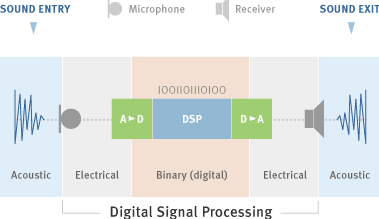
The hearing professional programs the hearing aid with a computer and can adjust the sound quality and response time on an individual basis. Digital hearing aids use a microphone, receiver, battery, and computer chip. Digital circuitry provides the most flexibility for the hearing professional to make adjustments for the hearing aid.

Digital circuitry can be used in all types of hearing aids and is typically the most expensive. However, digital hearing aids can be specially programmed with multiple programs for quiet situations, background noise reduction, music listening, and directionality. Many also have more powerful feedback-reduction and/or cancellation technology. Among digital hearing instruments, some companies are providing hardwired configurable platform, while others are providing software programable platform based on the utilization of a programable low power DSP.
Adjustment to Hearing Aids
For the majority of users, hearing aids will not completely restore or fix hearing loss; they are an aid to make sounds accessible to those who have hearing loss. Two problems occur with hearing loss that cannot be assisted by hearing aids:

i.)When the auditory cortex of the brain does not receive input/stimulation (i.e. what happens in hearing loss), this part of the brain may start to lose cells, and the ability to process sound. This is most common with more severe hearing losses, and cannot be reversed with hearing aids. Although this cell loss is worse in severe hearing loss, it is seen in all amounts of hearing loss and is caused by sensory deprivation.

ii.)Damage to the hair cells of the inner ear result in sensorineural hearing loss. When these hair cells are damaged, a person loses some ability to discriminate between sounds. This will likely cause decreased ability to understand speech. In this case, amplifying speech (as a hearing aid does) does not always improve speech understanding.
Multiple follow-up visits are common, particularly for new hearing aid users. The most common complaint about hearing aids, especially when someone starts wearing them for the first time, is that the sound of their own voice is too loud or that it sounds like they are talking into a barrel. Most hearing aid users will adjust to the sound of their own voices within several months if the aids are worn regularly. If the problem persists, ask your dispenser or audiologist if any adjustments can be made to the hearing aid.

![Reblog this post [with Zemanta]](http://img.zemanta.com/reblog_e.png?x-id=ac5037d3-3299-44b3-8eb6-11861c351bd8)